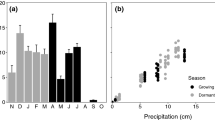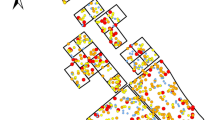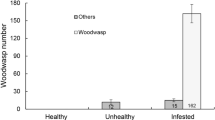Abstract
Many bluestain (ophiostomatoid) fungi are inoculated into trees via bark beetle activity, but their ecological roles are not fully understood, particularly for interactions with invertebrates outside bark beetle and phoretic mite associations. Recently, correlational field studies and small-scale laboratory feeding trials have demonstrated subterranean termites have increased presence on and preferential feeding of bluestain-infected wood, but experimental field evidence is lacking. To test the hypothesis that bluestain fungi increase termite presence in infected trees, we inoculated 72 loblolly pine trees in the southeastern USA with one of four bluestain fungi (Ophiostoma minus, O. ips, Leptographium terebrantis, L. procerum), a combination (O. minus + L. terebrantis), or H2O as a control. Over four years, all fungi-inoculated trees formed lesions around injection sites, while control trees formed no lesions except for two contaminated control trees that were excluded from analyses. Bluestain-inoculated trees had increased termite presence in and around fungal lesions, whereas control trees had no termites present. Specifically, termites were present on 35 % of fungi-inoculated trees, presence was consistent over time, and there was no difference among fungal species. This study experimentally demonstrates a link between bluestain fungi and subterranean termites in forests, which could impact tree dynamics post-bluestain infection.


Similar content being viewed by others
References
Bais HP, Weir TL, Perry LG, Gilroy S, Vivanco JM (2006) The role of root exudates in rhizosphere interactions with plants and other organisms. Annu Rev Plant Biol 57:233–266
Botch PS, Brennan CL, Judd TM (2010) Seasonal effects of calcium and phosphates on the feeding preference of the termite Reticulitermes flavipes (Isoptera: Rhinotermitidae). Sociobiology 55:489–498
Bradford MA, Warren RJ II, Baldrian P, Crowther TW, Maynard DS, Oldfield EE, Wieder WR, Wood SA, King JR (2014) Climate fails to predict wood decomposition at regional scales. Nat Clim Change 4:625–630
Clarke SR, Riggins JJ, Stephen FM (2016) Forest management and southern pine beetle outbreaks: a historical perspective. For Sci 62:166–180
Clay NA, Donoso DA, Kaspari M (2015) Urine as an important source of sodium increases decomposition in an inland but not coastal tropical forest. Oecologia 177:571–579
Coulson RN, Klepzig KD (2011) Southern pine beetle II. US Department of Agriculture, Forest Service, Southern Research Station, Asheville
Coyle DR, Klepzig KD, Koch FH, Morris LA, Nowak JT, Oak SW, Otrosina WJ, Smith WD, Gandhi KJK (2015) A review of southern pine decline in North America. For Ecol Manag 349:134–148
Eckhardt LG, Weber AM, Menard RD, Jones JP, Hess NJ (2007) Insect–fungal complex associated with loblolly pine decline in central Alabama. For Sci 53:84–92
Eggleton P, Tayasu I (2001) Feeding groups, lifetypes and the global ecology of termites. Ecol Res 16:941–960
Grace JK (1987) Association of the eastern subterranean termite, Reticulitermes flavipes (Kollar) (Isoptera: Rhinotermitidae), with living trees in Canada. J Entomol Sci 22:353–354
Grayston SJ, Jones DVD (1996) Rhizosphere carbon flow in trees, in comparison with annual plants: the importance of root exudation and its impact on microbial activity and nutrient availability. Appl Soil Ecol 5:29–56
Jouquet P, Traoré S, Choosai C, Hartmann C, Bignell D (2011) Influence of termites on ecosystem function. Ecosystem services provided by termites. Eur J Soil Biol 47:215–222
Klepzig KD, Raffa KF, Smalley EB (1991) Association of an insect–fungal complex with red pine decline in Wisconsin. For Sci 37:1119–1139
Klepzig KD, Moser JC, Lombardero FJ, Hofstetter RW, Ayres MP (2001) Symbiosis and competition: complex interactions among beetles, fungi, and mites. Symbiosis 30:83–96
Kurz WA, Dymond CC, Stinson G, Rampley GJ, Neilson ET, Carroll AL, Ebata T, Safranyik L (2008) Mountain pine beetle and forest carbon feedback to climate change. Nature 452:987–990
Lewis KJ, Hartley ID (2006) Rate of deterioration, degrade, and fall of trees killed by mountain pine beetle. BC J Ecosyst Manag 7:11–19
Little NS, Riggins JJ, Schultz TP, Londo AJ, Ulyshen MD (2012a) Feeding preference of native subterranean termites (Isoptera: Rhinotermitidae: Reticulitermes) for wood containing bark beetle pheromones and blue-stain fungi. J Insect Behav 25:197–206
Little NS, Blount NA, Londo AJ, Kitchens SC, Schultz TP, McConnell TE, Riggins JJ (2012b) Preference of Formosan subterranean termites for blue-stained southern yellow pine sapwood. J Econ Entomol 105:1640–1664
Little NS, Schultz TP, Diehl SV, Nicholas DD, Londo AJ, Musser FR, Riggins JJ (2013a) Field evaluations of subterranean termite preference for sap-stain inoculated wood. J Insect Behav 26:649–659
Little NS, McConnell TE, Irby NE, Shi SQ, Riggins JJ (2013b) Surface free energy of blue-stained southern pine sapwood obtained from bark beetle-attacked trees. Wood Fiber Sci 45:206–214
Maynard DS, Crowther TW, King JR, Warren RJ, Bradford MA (2015) Temperate forest termites: ecology, biogeography, and ecosystem impacts. Ecol Entomol 40:199–210
McMinn JW, Crossley DA (1993) Biodiversity and coarse woody debris in southern forests. USDA Forest Service General Technical Report SE-94
Meddens AJH, Hicke JA, Ferguson CA (2012) Spatiotemporal patterns of observed bark beetle-caused tree mortality in British Columbia and the western United States. Ecol Appl 22:1876–1891
Müller J, Buẞler H, Goẞner M, Rettelbach T, Duelli P (2008) The European spruce bark beetle Ips typographus in a national park: from pest to keystone species. Biodivers Conserv 17:2979–3001
Nowak JT, Meeker JR, Coyle DR, Steiner CA, Brownie C (2015) Southern pine beetle infestations in relation to forest stand conditions, previous thinning, and prescribed burning: evaluation of the southern pine beetle prevention program. J For 113:454–462
Osbrink WLA, Woodson WD, Lax AR (1999) Populations of Formosan subterranean termite, Coptotermes formosanus (Isoptera: Rhinotermitidae), established in living urban trees in New Orleans, Louisiana, U.S.A. In: Robinson WH, Rettich F, Rambo GW (eds) U.S.A. Proceedings, 3rd international conference on urban pests. Graficke Zavody Hronov, Czech Republic, pp 341–345
Otrosina WJ, Bannwart D, Roncadori RW (1999) Root-infecting fungi associated with a decline of longleaf pine in the southeastern United States. Plant Soil 217:145–150
Pan Y, Birdsey R, Fang J, Houghton R, Kauppi PE, Kurz WA, Phillips OL, Shvidenko A, Lewis SL, Canadell JG, Ciais P, Jackson RB, Pacala SW, McGuire AD, Piao S, Rautiainen A, Sitch S, Hayes D (2011) A large and persistent carbon sink in the world’s forests. Science 333:988–993
Prestwich GD, Bently BL, Carpenter EJ (1980) Nitrogen sources for neotropical nasute termites: fixation and selective foraging. Oecologia 46:397–401
Riggins JJ, Little NS, Eckhardt LG (2014) Correlation between infection by Ophiostomatoid fungi and the presence of subterranean termites in loblolly pine (Pinus taeda L.) roots. Agr For Entomol 16:260–264
Sambaraju KR, Carroll AL, Zhu J, Stahl K, Moore RD, Aukema BH (2012) Climate change could alter the distribution of mountain pine beetle outbreaks in western Canada. Ecography 35:211–223
Schowalter TD (1981) Insect herbivore relationship to the state of the host plant: biotic regulation of ecosystem nutrient cycling through ecological succession. Oikos 37:126–130
Six DL, Wingfield MJ (2011) The role of phytopathogenicity in bark beetle–fungus symbioses: a challenge to the classic paradigm. Annu Rev Entomol 56:255–272
Tingey DT, Manning M, Grothaus LC, Burns WF (1980) Influence of light and temperature on monoterpene emission rates from slash pine. Plant Physiol 65:797–801
Vanderwel MC, Malcolm JR, Smith SM (2006) An integrated model for snag and downed woody debris decay class transitions. For Ecol Manag 234:48–59
Wang C, Powell J (2001) Survey of termites in the Delta Experimental Forest of Mississippi. Fla Entomol 84:222–226
Wingfield MJ, Seifert KA, Webber JF (eds) (1993) Ceratocystis and Ophiostoma: taxonomy, ecology, and pathogenicity. American Phytopathological Society Press, St. Paul
Acknowledgments
Thanks to John Formby, John Thomason, Jared Seals, Michael Campbell, Nathan Blount, and Kevin Chase for assistance in the field. Special thanks to Misty Booth and the College of Forest Resources at Mississippi State University for providing trees in the John Starr Forest Experimental Forest, and to Chip Doolittle and ArborSystems who donated the tree injection equipment. Comments from David Coye improved the manuscript. This research was supported by funds from the Mississippi Agricultural and Forestry Experiment Station at Mississippi State University.
Author information
Authors and Affiliations
Corresponding author
Ethics declarations
Conflict of interest
NL and JR are coinventors on a pending patent application involving bluestain fungi in baiting methods for termites. Authors and their institutions may financially benefit from this patent.
Additional information
Handling Editor: Heikki Hokkanen.
Rights and permissions
About this article
Cite this article
Clay, N.A., Little, N. & Riggins, J.J. Inoculation of ophiostomatoid fungi in loblolly pine trees increases the presence of subterranean termites in fungal lesions. Arthropod-Plant Interactions 11, 213–219 (2017). https://doi.org/10.1007/s11829-016-9473-5
Received:
Accepted:
Published:
Issue Date:
DOI: https://doi.org/10.1007/s11829-016-9473-5




